Human Nervous System
1/35
Earn XP
Description and Tags
Name | Mastery | Learn | Test | Matching | Spaced |
|---|
No study sessions yet.
36 Terms
What is the function of the nervous system?
The nervous system allows the body to react to its surroundings and coordinate an appropriate response.
How does a stimulus lead to a response being carried out by the body?
Stimulus is converted into an electrical impulse by the receptors.
The electrical impulse passes along sensory neurones to the central nervous system (CNS).
The CNS coordinates an appropriate response and an electrical impulse is sent along motor neurones to the effector, which carries out the response.
What sequence of events describes how the nervous system works?
Stimulus → receptor → coordinator → effector → response
What is a reflex action?
A reflex action is an automatic and rapid response which does not involve any conscious input from the brain.
Why are reflex actions important?
Reflex actions aid survival by preventing harm to the body.
Describe how a reflex action occurs via a reflex arc
The stimulus is detected by a receptor.
An electrical impulse passes along a sensory neurone to the spinal cord (part of the CNS).
At a synapse between a sensory neurone and a relay neurone, a chemical diffuses across the gap and stimulates a new impulse which passes along the relay neurone.
The same process occurs at a synapse between a relay neurone and a motor neurone.
At the effector, an appropriate response is carried out.
What is the difference between a reflex pathway and a conscious pathway?
Within a reflex pathway, the coordination centre is a relay neurone found in the spinal cord/unconscious parts of the brain. In a conscious pathway, the coordination centre is in the conscious part of the brain.
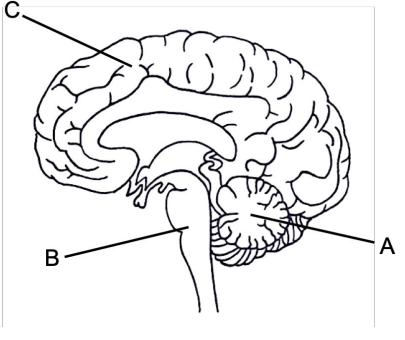
Which letter is the cerebral cortex and what is the function of the cerebral cortex?
C - controls consciousness, intelligence, memory and language.
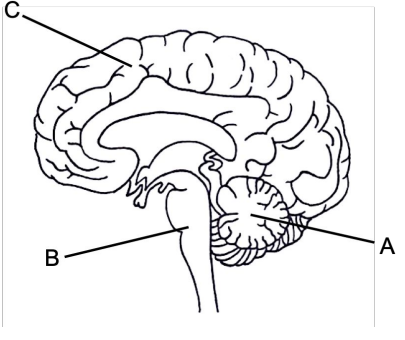
Which letter is the cerebellum and what is the function of the cerebellum?
A - controls muscular coordination
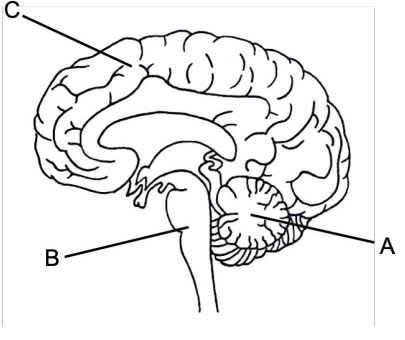
Which letter is the medulla and what is the function of the medulla?
B - controls unconscious activities eg. breathing, heart rate
Why is the investigation and treatment of the brain difficult?
The brain is a complex and delicate organ.
The brain is easily damaged and destroyed.
Certain membranes prevent drugs from reaching the brain.
The exact function of each part of the brain is not known.
What methods are used by scientists to determine brain function?
Studying patients with brain damage
Electrical stimulation of the brain
MRI scans
What stimuli are the receptors of the eye sensitive to?
Light intensity and colour
What are the two main functions of structures found within the eye?
Focusing on near or distant objects - accommodation.
Adaptation to dim light.
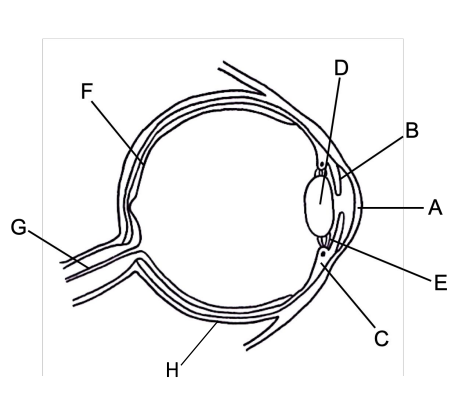
Which letter is the retina and describe the structure and function of the retina.
F - The retina is a light-sensitive layer found at the back of the eye. Light stimulates the retinal cells, resulting in impulses being sent to the brain.
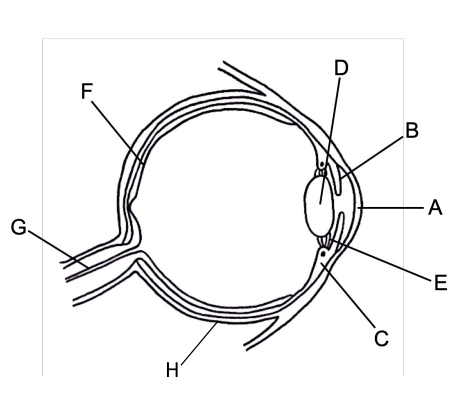
Which letter is the optic nerve and describe the structure and function of the optic nerve.
G - The optic nerve connects the eye and the brain. It carries impulses to the brain so that an image can be visualised.
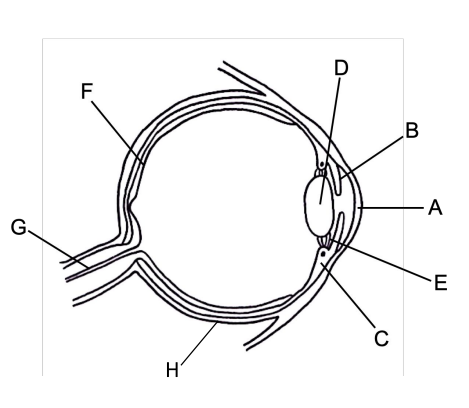
Which letter is the sclera and describe the structure and function of the sclera.
H - The sclera is the tough outer layer of the eye which protects its internal structures.
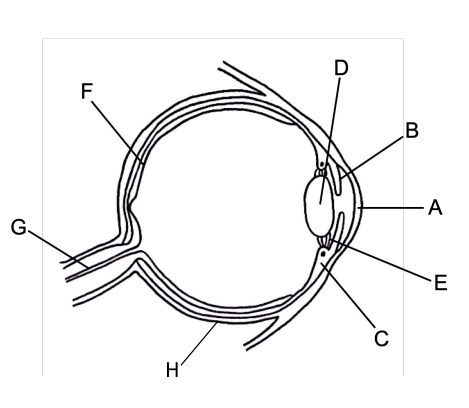
Which letter is the cornea and describe the structure and function of the cornea.
A - The cornea is the curved transparent layer at the front of the eye. It lets light into the eye and allows light to be focused onto the retina.
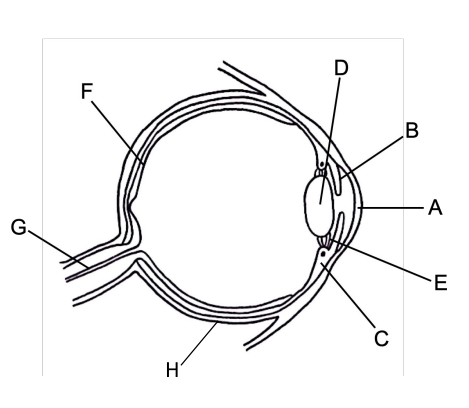
Which letter is the iris and describe the structure and function of the iris.
B - The iris is a muscle which controls the size of the pupil by contracting or relaxing. This allows the eye to adjust to bright and dim lighting
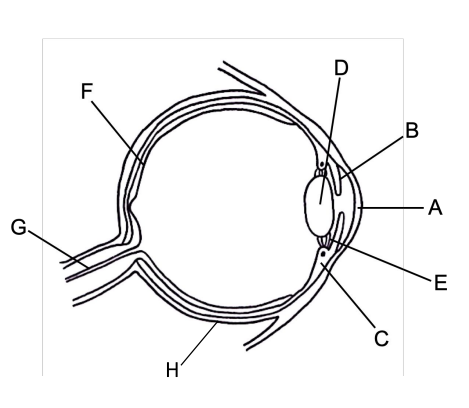
Which letters are the ciliary muscles and suspensory ligaments and describe the structure and function of the ciliary muscles and suspensory ligaments.
The ciliary muscles (C) and suspensory ligaments (E) hold the lens in place and control its shape.
Describe how the iris alters the size of the pupil in both bright and dim light.
Bright light: circular muscles contract and radial muscles relax - makes pupil smaller to avoid retinal damage.
Dim light: circular muscles relax and radial muscles contract - makes pupil larger so more light can enter the eye.
What is accommodation?
Accommodation is the alteration of the lens’ shape in order to focus on near or distant objects.
How does the eye focus on a nearby object?
Ciliary muscles contract.
Suspensory ligaments loosen.
Lens becomes thicker and more curved - light rays are refracted strongly.
How does the eye focus on a far away object?
Ciliary muscles relax
Suspensory ligaments tighten
Lens becomes thinner - light rays are refracted weakly
What is myopia?
Myopia (short-sightedness) usually occurs when the lens of the eye is too curved. As a result, light is focused in front of the retina so images appear blurry.
How can myopia be treated?
Myopia can be treated using glasses with a concave lense, which spreads out light rays so they can be focused on the retina.
What is hyperopia?
Hyperopia (long-sightedness) usually occurs when the lens of the eye is too flat. As a result, light is focused behind the retina so images appear out of focus.
How can hyperopia be treated?
Hyperopia can be treated using glasses with a convex lense, which brings the light rays together so they can be focused on the retina
What are the two types of contact lenses?
Contact lenses are lenses that are placed on the eye. There are two types:
Hard - rigid material, last a long time, must be kept sterile.
Soft - flexible material, last for a shorter time, more comfortable.
What is laser eye surgery?
Laser eye surgery is the use of lasers to fix visual defects in adults. To treat myopia, lasers reduce the thickness of the cornea so light is refracted less strongly. To treat hyperopia, lasers alter the curvature of the cornea so that light is refracted correctly.
How can replacement lenses be used to treat visual defects?
A replacement lens can either implanted into the eye (along with the natural lens) or it may replace the natural lens altogether.
What are the risks of lens replacement?
Risks of lens replacement include retinal damage, cataracts and infections.
Where is body temperature controlled in the body?
Body temperature is controlled by the thermoregulatory centre in the hypothalamus of the brain.
How is temperature monitored by the body?
Thermoregulatory centre has receptors sensitive to blood temperature.
Skin has receptors sensitive to skin temperature - sends impulses to thermoregulatory centre.
What physiological changes occur when the body temperature is too high?
Vasodilation - blood vessels near the surface of the skin dilate - more heat is radiated away.
Sweating - evaporation of water takes away heat energy from the surface of the skin.
What physiological changes occur when the body temperature is too low?
Vasoconstriction - blood vessels near the surface of the skin constrict - less heat radiated away.
Shivering - respiration allows muscles to contract. It is an exothermic process, so heat energy is released.
Sweating stops